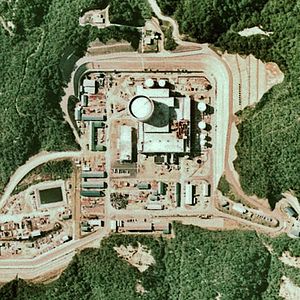This article needs additional citations for verification. (March 2011) |
| Fugen Nuclear Power Plant | |
|---|---|
 The Fugen NPP in 1975, Image: Japan Ministry of Land, Infrastructure and Transport | |
 | |
| Country | Japan |
| Coordinates | 35°45′16″N 136°00′59″E / 35.75444°N 136.01639°E |
| Status | Decommissioned |
| Construction began | May 10, 1972 |
| Commission date | March 20, 1979 |
| Decommission date | March 29, 2003 |
| Operator | Japan Atomic Energy Agency |
| Nuclear power station | |
| Reactor type | HWLWR |
| Power generation | |
| Units decommissioned | 1 x 165 MW |
| Nameplate capacity | 165 MW |
| Capacity factor | 23.9% |
| Annual net output | 345 GW·h |
| External links | |
| Website | www |
| Commons | Related media on Commons |

Fugen ふげん (Fugen) was a prototype Japanese nuclear test reactor. Fugen was a domestic Japanese design for a demonstration Advanced Thermal Reactor. It was a heavy water moderated, boiling light water cooled reactor.[1] The reactor was started in 1979 and shut down in 2003. As of 2018, it is undergoing decommissioning.[1] It is located in Myōjin-chō, in the city of Tsuruga, Fukui. The name "Fugen" is derived from Fugen Bosatsu (Samantabhadra), a Buddhist deity.
The reactor was the first in the world to use a full MOX fuel core. It had 772 assemblies, the most in the world. It has received the title of a historic landmark from the American Nuclear Society.
The design boils ordinary water like a boiling water reactor (BWR) but uses heavy water as a moderator as in a CANDU reactor. The electrical output was 165 MW and the thermal output was 557 MW.
- Core temperature: 300 °C
- Pellet centerline temperature: 2200 °C
- Fuel conversion time: 6 months
The plant is located on a site that covers 267,694 m2 (66 acres); buildings occupy 7,762 m2 (1.9 acres), and it has 46,488 m2 of floor space. It employed 256 workers.[2]
- ^ a b "History of Fugen | Reactor Decommissioning Research and Development Center". www.jaea.go.jp. Retrieved 10 July 2018.
- ^ JAEA (Japanese). Facilities Quick View Archived 2012-04-20 at the Wayback Machine.